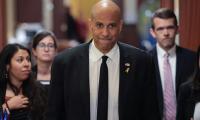ISLAMABAD: About 800,000 to one million people have got unemployed because of slow down in the economy, whereas four million people have gone down the poverty line so far and in next two fiscal years, about 8,000,000 people are feared to go down below poverty line.
Dr Hafeez Pasha, a distinguished economist of the country, an interview with The News painted the future outlook of the country’s economy after joining the three-year IMF loan program.
He said that since the GDP growth will stay in current and next financial years at about 3 percent and after that it may grow to 4 percent, which will cause increase in unemployment and about 8,000,000 people will go down below the poverty line.
“More importantly, inflation is feared to reach a peak double-digit rate in 2019-20 particularly due to the continuing depreciation of rupee and higher indirect tax burden. And it will stay high single-digit the next two years and the target is to bring it down to below 5 percent from 2021-22 onwards,” he said.
Dr Pasha mentioned that the current financial year will end up with almost 7 percent budget deficit. This time, he said, the debt servicing will eat up mammoth amount of Rs2.6 trillion and the defence budget will also increase given the situation on eastern and western borders.
The federal government has almost 42 ministries and divisions and 206 are attached departments and autonomous bodies in the presence of the 18th Amendment. Pasha said the government should reduce its ministries and attached department with a view to curating the running expenditures.
To a question, he said, if the country faces any political upheaval that may lead to instability, then Pakistan’s economy will be the most vulnerable with far reaching adverse impacts on the countrymen.
“I wish Pakistan does not experience any kind of political expediency,” he said, mentioning 126 days sit-in during the Nawaz Sharif government which had inflicted huge loss to the economy. Since then, Pakistan’s stock exchange dwindled by 35 percent, resulting in mammoth loss of $30 billion.’
He said that in next two years, Pakistan need to pay back $40 billion loan whichlooks horrible given the economic situation of the country. This government has so far borrowed $9.4 billion which include $4.4 billion from China, $3 billion from Saudi Arabia and $2 billion from the UAE. The said loan from the three countries is deposited with the State Bank of Pakistan as reserves. Dr Pasha said that China is the only hope left with Pakistan as if Beijing agrees to rollover its almost $20 billion loans for three years’ time, it will provide breathing space to the government. He said once Pakistan goes into IMF programme, then the country may get $6-8 billion loan which will be in fact $3-5 billion as some of the amount will be consumed to pay back the previous loans to the Fund. However, by joining the IMF, other international financial institutions (IFIs) such as World Bank, Asian Development Bank and Islamic Development Bank will provide concessional loan of about $6-7 billion.
Dr Pasha said had Prime Minister Imran Khan raised the issue of rollover of the loan with Chinese leadership during the recent visit, it would have given the substantial leverage while holding parleys with the IMF. He hoped that the prime minister must have taken up this vital issue with Chinese top leadership.
In case Pakistan succumbs to IMF demand seeking revenue generation up to Rs700 through taxation in 2019-20 budget, it will tantamount to playing havoc with the economy as people will not pay more when the growth will be in the lowest ebb. “This will suffocate the country’s economy,” he said.
Dr Pasha said the government should generate more revenue of Rs650 billion in next two financial years. He said that government can increase more revenue of Rs100 billion through the mobile cards. He also drew the attention towards the low hanging fruit in the provinces. He said it is high time to start collecting the income tax on agriculture and generate revenue through increase in property tax on immovable property.
He said that just Rs2 billion is collected per annum through income tax on agriculture as against the income tax of Rs1,500 billion from the sectors of economy. He said the agriculture is the 20 percent of the GDP, but its contribution towards tax revenue is just at Rs2 billion. Dr Pasha mentioned that property tax in Mumbai, India of about Rs100 billion is collected, whereas in Pakistan just Rs16 billion is collected under the head of property tax. “These are the areas where tax authorities need to work and can easily earn revenue of Rs100 billion on these two accounts,” he said.
Dr Pasha also disclosed that water tax (Abiana) stands at Rs135 per acre in one year whereas the expenditure of the government (irrigation department) on one acre stands at Rs3,000. He said in Punjab alone, the water tax of Rs2 billion is collected per annum, whereas the government expenditure stands at Rs50 billion.
Talking of current account deficit, Pasha said it exceeded 6 percent of the GDP and is likely to be close to 4.5 percent of the GDP in 2018-19. He said there is need for a sharp reduction in this deficit to almost 2 percent of the GDP by 2021-22.
Mentioning the tax-to-GDP ratio, he said that it hiked to 13 percent of the GDP by 2017-18. However, he said, due to slow growth in tax revenues in 2018-19 it is likely to fall below 12.5 percent of the GDP in 2018-19. Maximum effort will have to be made to boost tax revenues in 2019-20 by over 1 percent of the GDP. This effort will need to continue until the tax-to-GDP ratio rises to 16 percent by 2023-24. He said that various studies, including those by Unesco, have estimated the tax revenue potential of Pakistan at 16 percent of the GDP. Over the next five years period, the great challenge will be to raise the tax-to-GDP ratio by 3.5 percent of the GDP.
Highlighting the salient features of the home-grown macroeconomic framework finalised by himself (Dr Hafeez Pasha), and Dr Shahid Kardar, he said the government needs to contain imports and to this effect the government has so far reduced the import by $3.5 billion which will be further reduced by $5-6 billion by June 30, 2019. “The rupee has been depreciated by 16 percent up to now in 2018-19. Today, there is no significant overvaluation of the rupee. Luxury goods imports have been restricted by the imposition of large regulatory duties and 100 percent cash margin requirements. However, their coverage is only 6 percent of imports currently,” he said.
The approach adopted is to ensure that in the future there is no significant overvaluation of the rupee. He said that a 15 percent real depreciation of the rupee is envisaged during 2019-20 and 2020-21. Simultaneously, it is proposed to widen the coverage of the cash margins of up to 30 percent. Imports of major essential goods like POL products, fertilisers, medicines, pulses and edible oil should not be subject to cash margin requirements. In addition, it is proposed to raise the maximum import tariff from 20 percent to 25 percent to provide more protection to domestic industry.
About exports, he said many steps have already been taken to promote exports. These include depreciation of rupee, lower power tariffs, duty exemption on imported inputs for exports, issuance of promissory notes against refunds due and an export incentive scheme. However, despite these wide-ranging measures there has been no visible improvement in exports. It appears that exporters have largely opted initially for increase in their rupee profit margins. As such, the benefit of the devaluation has only been passed on partially to buyers in the form of lower dollar prices.







